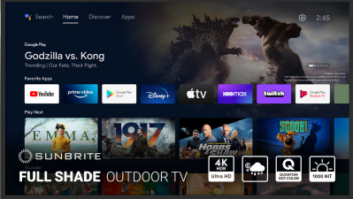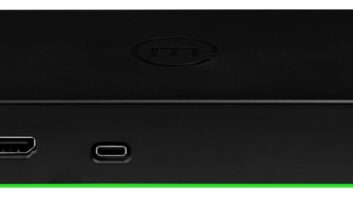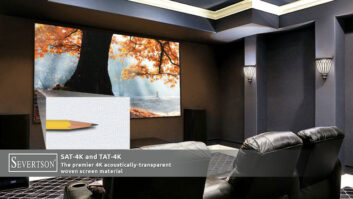Question: What do Wal-Mart, Kmart and Target sell?
Answer: Anything they want.
With nearly 8,000 large-format stores between them, and some $9 billion in consumer electronics sales last year, the discount channel’s Big Three truly are the 500-pound gorillas of retail.
Fortunately for electronics specialists, what these general merchandise colossi want, for the time being at least, is to continue bottom feeding at the low end of the CE spectrum.
Working against any short-term challenge to specialty stores’ high-tech hegemony is the basic tenet of the discount trade: volume. Whether it’s detergent, denim or DVDs, goods must fly across the counter to compensate for the channel’s rapier-thin markups.
Also, the business model neither abides selling floor tutorials, nor allows for the compensation commanded by trained and well-versed CE sales folk. Taken together, these factors represent a fairly significant barrier to the consumer-confounding categories born of the digital revolution.
But don’t write off the marts’ high-end aspirations just yet. To varying degrees, each of the Big Three has waded into the e-commerce waters, where the rules of engagement are still being written. While the Internet has been lauded as the great equalizer in retail, the equation cuts both ways: The same medium that gives the single-unit specialist a worldwide platform can also provide a 2,000-unit general store with a veneer of electronics expertise.
What’s more, the initial no-overhead theory that assigned an advantage to pure-play e-tailers has already been replaced by the realization that a nationwide network of click-and-mortar storefronts is preferable for distribution and customer support.
Meanwhile, regardless of their digital direction, the Big Three simply cannot be ignored. The trio alone accounts for 13% of all CE sales according to TWICE’s 1999 Retail Registry. As CompuDawn chairman R.E. “Teddy” Turner said last week in announcing the sale of his $300 GlobalPC computers to Wal-Mart and Kmart, “[They] have nearly 6,000 storefronts combined, and Wal-Mart alone sees 100 million shoppers each week.”
With that, TWICE now casts a watchful eye toward retail’s fearsome threesome based on analyst insights, financial disclosures, e-commerce accomplishments and in-store visits to their electronics departments.
Wal-Mart: The world’s largest — and arguably best — retailer (at least at POS information, inventory management and vendor intimidation) enjoyed another bang-up quarter for the period ended July 31. Wal-Mart’s 2,454 stores and supercenters generated revenue of $26.6 billion, up 15% from the year-ago quarter, while comp-store sales grew a respectable 8.3%. Operating profit was up 20% to $2.2 billion from the $1.8 billion garnered last year as the mega merchant continued to slash costs and curry favor on Wall Street.
A recent visit to a six-year-old Wal-Mart store in central New Jersey found the electronics department in its usual central locale. The only enclosed department, ostensibly to discourage shoplifting, the section was well-stocked, heavily trafficked and moderately housekept.
In addition to music CDs and cassettes, the aisles were packed with portable audio products, telephones and Hewlett-Packard peripherals. A TV wall filled the back row, highlighted by a pair of 52-inch projection TVs from RCA and Philips Magnavox priced at $1,499 and $1,399, respectively.
A display of tethered brand-name cameras and camcorders was located across from the cash register, and a pile of HP Pavilion PCs was stacked by the entrance. The 450MHz models were bundled with a 17-inch monitor and a printer in a specially priced $1,298 package.
Amy Wright, a channels analyst with market research firm ARS in La Jolla, Calif., doubts that Wal-Mart will “trade up” its merchandise mix to compete with more specialized retailers. But she cautioned that “Wal-Mart is in the process of building a competitive web site that some speculate will become as big online as it is in the physical retail market.”
Wal-mart.com currently sells PCs and peripherals, software, home audio, telephones, cameras and personal audio products, and recently settled a lawsuit with Amazon.com over Amazon’s use of proprietary Internet systems that were gleaned from former Wal-Mart employees.
Target: Target’s pre-tax profit in the quarter ended July 31 increased 27% to $430 million from $337 million the year prior due to favorable markup and markdown performance. Total sales, buoyed by an aggressive store-building campaign in the Northeast, were up 12.6% for the quarter to $6 billion, while same-store revenues grew 6.5% for the period.
The more upscale of its peers, Target’s brighter and tidier stores, and more fashion-forward merchandise mix, reflect its Dayton Hudson heritage. As a result, said Wright, “Target attracts a different breed of customer that might ordinarily refuse to shop at the other discount retailers. Target shoppers tend to be better educated, and they are more likely to command higher salaries.”
True to form, a two-month-old Target store in central New Jersey featured the most sophisticated and well-stocked electronics department of the Big Three. Overhead signage boasted such brands as Sony, Philips, GE, RCA, Dish and WebTV, and Target was the only discounter to carry DVD players, including a top-of-the-line Panasonic DVD/CD changer for $449.99.
The TV wall was limited to small-screen sets that topped out at 32 inches (represented by a $549.99 RCA and a $579.99 model from Philips Magnavox). A VCR aisle started with a two-head Funai for $79.99, and offered a “Comparison Guide” brochure that listed makes, models and extended service plans.
Cameras, both digital and conventional, shared space in a glass case with personal organizers, including Royal’s da Vinci for $99.99, and the three sales associates stationed there appeared helpful and knowledgeable.
If Target offers the more sophisticated shopping experience — especially at its 124,000-square-foot Greatland superstores, which boast ambient lighting, terrazzo floors, and upgraded bathroom amenities — its Internet efforts are nascent. So far, only a small selection of home décor, gourmet and garden products are available at shop@@target, the discounter’s online moniker.
Kmart: Due largely to a one-time aftertax charge of $230 million related to its Builders Square lease obligations, Kmart reported a net loss of $96 million for the quarter ended July 28, compared with net income of $80 million the year prior. The retailer’s 2,151 stores pumped out $8.8 billion in revenue for the period, up 7.9% from the year-ago quarter, while same-store sales grew 5.9% for the period.
Kmart, the direct descendent of five-and-dime store S.S. Kresge, is the poor relation of the Big Three. Despite a heroic turnaround effort by chairman Floyd Hall — which included a new high-frequency “Big Kmart” store format, heavy emphasis on big-name private-label brands like Martha Stewart, Sesame Street, Jaclyn Smith and White-Westinghouse, and an aggressive store expansion and refurbishing strategy — the merchant still lags Wal-Mart in price and Target in style.
“I am concerned that Kmart will be incapable of withstanding the competition it faces from Target and Wal-Mart,” said Wright. “It positions itself as a middling player between the two in terms of the quality of its stores, and there simply may not be room for it in the market.”
Besides market position, Kmart also struggles with core retail competencies like shelf replenishment and housekeeping. Both problems were evident in central New Jersey at a recently refurbished Big K store, whose electronics department was distinguished by bare shelves and aisles choked with large cartons. A display of VCRs lacked prices, and DVD players were nonexistent despite signage in the adjacent software department that touted the technology’s benefits.
The bulk of the store’s CE offerings were confined to small-screen TVs, portable audio, cordless phones, cameras, and low-end shelf stereo systems. One salesperson manned the department, a teenager who readily conceded having no knowledge of several products that were inquired about.
Things are more inviting online, where kmart.com offers a limited selection of home furnishings, software, gifts, exercise equipment, baby products and software.












